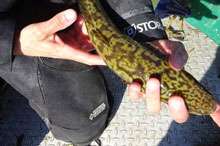No products in the cart.
The Kootenai Leopard

Once Rare, Now Returning
By Mary Terra-Berns
I was anxious to see what was in the net. The winch slowly spooled back rope and brought the hoop net up from the bottom of the river. Idaho Department of Fish and Game (IDFG) senior fishery research biologist T.J. Ross worked the winch while technician Travis Morhardt maneuvered the boat to maintain our position in the strong current. I tried to stay out of the way.
We had put in at the Deep Creek launch, on the Kootenai River, early in the morning and headed downstream on this final day of the winter survey’s net-checking and removal. I was there to help record any catches, to break down the nets, and get gear ready to store until next season. But really, I was hoping to see the “Leopard of the Kootenai,” the eel-like burbot. I leaned over the edge of the boat, waiting for the net to come into view.
The word “burbot” comes from the Latin word barba, which means beard. Burbot, both male and female, sport a minimal beard of a single heavy-duty chin whisker called a barbel. Because of their mottled light and dark markings, and their strong predatory behavior, burbot have acquired the leopard alias. To me, they look like a moray eel doppelganger with fins and a chin hair, or maybe a catfish in a fancy coat.
This content is available for purchase. Please select from available options.
Register & Purchase Purchase Only
Register & Purchase Purchase Only

